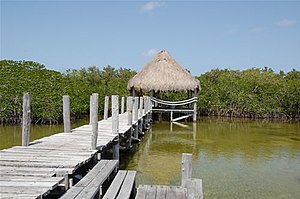A palapa (a Spanish word of Tagalog origin, originally meaning "petiole of the palm leaf") is an open-sided dwelling with a thatched roof made of dried palm leaves.[1] It is very useful in hot weather and, therefore, very common on Mexican beaches and deserts.

According to Rubén Carrillo, palapa is derived from the traditional construction methods of the bahay kubo ("nipa hut") architectural style of the Philippines, carried to Nueva España (along with coconuts, which are not native to the Americas) via the Manila galleons during the Spanish colonial period.[2]
Palapas are also common in Honduras and other Central American countries.
See also
edit- Barra de Potosi
- Bohío, Caribbean dwelling with palm thatched roof once commonly found in Puerto Rico, Cuba and Hispaniola.
- Chickee, the Creek/Seminole word to describe an open dwelling with a palm thatched roof frequently constructed by Florida's Native Americans.
- Manila Galleons, Spanish Colonial Mexico and Spanish East Indies trade/cultural exchange route.
References
edit- ^ "Pilipinas". Pilipinas (39–43). Honolulu, Hawaii: Philippine Studies Committee, Southeast Asia Council, Association for Asian Studies: 31. 2002.
palapa is listed in the American Heritage Dictionary which considers the word to be of American-Spanish origin. However, we could ultimately trace the roots of the word to the Philippines. Palapa (Tagalog) refers to an opensided structure with thatched roof made of dried palm fronds, usually found on beaches and used as shade.
- ^ Carrillo, Rubén. "Asia llega a América. Migración e influencia cultural asiática en Nueva España (1565-1815)". www.raco.cat. Asiadémica. Retrieved 19 December 2016.